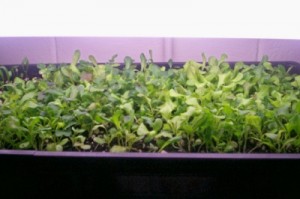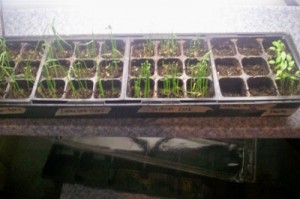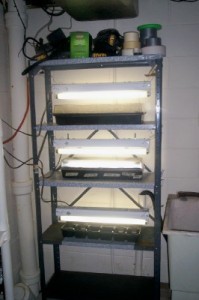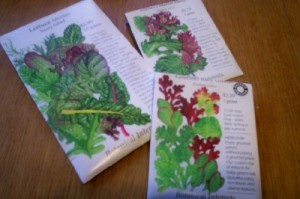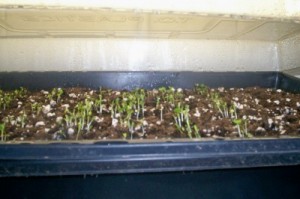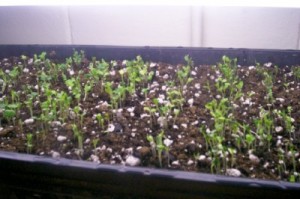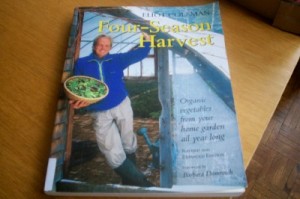First off, I apologize for not posting more once the garden started producing. We were pregnant with our first child, and once the garden had ripe fruit it produced like crazy until mid-October. I was running solo on all garden work and post garden work (processing all the wonderful proceeds). At its height I was picking between 10 and 15 pounds of tomatoes every time I went into the garden (tried to limit myself to every other day for my wife’s sake).
I made a lot of salsa.
I made 170 or so jars of salsa this year (52? when Erika was here), but we gave away a ton for Christmas presents. I think we made a decent amount, but I was ready to be done when I was making the last batch. Even with all that salsa we had plenty of tomatoes, and sent home a ton with Erika and family at Labor day. That was from 23 plants (had to yank one, and one other I did not get anything edible from). It was also a perfect growing season here in Minnesota, so everything was very productive.
Some thoughts on the salsas.
Zesty – This recipe is from the Ball Complete Book of Home Preserving. This is my favorite recipe, and each batch tastes a little different with different levels of heat depending on which tomatoes and which peppers were ripe. Usually this ends up on the stronger side of medium, and one batch I would consider a mild hot.
Anna’s – This is actually the “Annie’s Salsa” recipe from online somewhere. We do not add any tomato paste or sugar (makes the salsa taste like tomato sauce). This is my wife’s favorite recipe, and the cumin adds a smoky flavor to the salsa.
Jalapeno – This is also from the Ball book, and is one of my favorites. This recipe is quite spicy, and is great cooked into other foods. My favorite is to put a tablespoon or two into my scrambled eggs as I am cooking them.
Roasted Chipotle – This recipe (from Ball book) is supposed to be made with Chipotles (dried, smoked jalapenos) but I could not find any. So I used dried pablano and ancho peppers instead. Then I roasted the garlic, tomatoes, and peppers. This one has an interesting taste, and I will try it again next year with the right ingredients. Erika did make one batch with actual Chipotles, and I can’t wait to dig into that jar of salsa.
Spicy Tomato – Another recipe (from Ball book) that calls for dried peppers. I am only so-so on this one. I might try it again next year with chipotle peppers instead.
Mango salsa – I am not really into the sweet salsas as a general rule. This recipe (Online recipe. Make sure you check the source for online recipes as canned goods need to have a very specific acid content to be canned safely) calls for green mangos (the ripe mangos have too low of an acidic value to be used). At first I was only so-so on this one but it has been growing on me. It is excellent on fish tacos, and my wife informs me it was wonderful on warm brie.
Peach salsa – This was a very pleasant surprise. This one was also from the Ball book of canning. I hated making this recipe, as slicing up slippery, wet peaches is a real pain. The flavor makes up for it though. It is fabulous. I rate my friendships on whether I would give them a jar of peach salsa or not. It is precious to me.
I will not be growing Dr Wyche’s, Black Krim, Brave General, and Brandywine for sure, and probably not Yellow Pear. I might try and find Yellow Submarine and see if that is an improvement at all.
I was very disappointed in my Black Cherry production for having two plants. I only got 127 fruit vs 300 yellow pear (one plant) before I stopped picking them.
The Malakite was the king of the garden again, though Golden King of Siberia almost supplanted it.
Seeing saladette sized tomatoes on my Sungold plant was very disappointing, though to be fair they weren’t bad tasting tomatoes.
So here is the tomato count!
Yellow Pear – 307
Black Cherry – 127
Unknown Saladette – 127
Cuor Di Bue (2 plants) – 70
Pantano Romanesco (2 plants) – 32
Carbon (2 plants) – 39
Golden King of Siberia – 23
Cosmonaut Volkov – 33
Sungold (in a pot) – 34
Monomahk’s Hat – 12
Malakite – 40
Brave General – 27
Purple Russian – 36
Vorlon – 14
Golden Sunray – 18
Cowlick Brandy – 11
Dr Wyche’s – 6
Green Zebra – 56
Black Krim – 11
Pink Ponderosa – 32
A few notes about each variety –
Yellow Pear – 70 DTM – The tomatoes aren’t bad, but I hate how it tries to take over everywhere, it is very hard to manage this plant.
Black Cherry – 76 DTM – My favorite tasting tomato. I didn’t get enough of these to satisfy my desire for them, so I bought them from the farmers market as well.
Unknown Saladette – 71 DTM – This was supposed to be Sungold Select II. I guess I will need a different seed source for these next year. I had 3 out of 4 produce true to form, but two went to friends and the third was in a 5 gallon pail.
Cuor Di Bue – 72 DTM – Red oxheart that produced well. Flavor was decent and this one was also great for making soup and salsa.
Pantano Romanesco – 78 DTM – These all came out ribbed for me, very pretty tomato. Good for slicing, salsa, and pretty much anything else you wanted to use it for.
Carbon – 77 DTM – A true jewel of the garden this year. One of the best tasting tomatoes I have ever tried. Most of these were over a pound, and I had two over two pounds.
Golden King of Siberia – 70 DTM – A real surprise this year. These giant yellow fruit were bursting with flavor. I may have only gotten 23 fruit, but 2/3 of them were over a pound. You can see which batches of salsa have this tomato in them.
Cosmonaut Volkov – 70 DTM – A nice tasting pink beauty. This one will keep going in the garden as long as I have room.
Sungold (pot) – 71 DTM – A very sweet tasting tomato. My wife’s favorite, though I would take 1 black cherry over 10 sungolds any day.
Monomahk’s Hat – 71 DTM – A well balanced tomato for any use. I would take up valuable garden space with it again.
Malakite – 73 DTM – This plant produces loads of medium to large great tasting fruit. One of the first to start and the last to stop. This is a must grow.
Brave General – 77 DTM – This one will not make it back into my garden. I had optimal growing conditions yet this one was still watery and kind of mealy tasting.
Purple Russian – 79 DTM – THE find of the year. I could not believe it when I bit into this tomato for the first time. This one might actually taste better than black cherry, but it is hard to tell. It made the best everything we used it for. I will never go without growing this tomato if I have space for a garden.
Vorlon – 81 DTM – A great tasting tomato, but not very productive. I will give it another try in a better location to see if I can get more productivity out of it.
Golden Sunray – 81 DTM – Stunning orange fruit with a decent flavor. Very pretty to slice up and good for eating or salsa.
Cowlick Brandy – 86 DTM – Very disappointed with this tomato. It had been so hyped up to me but I thought it was just ok. I will not grow this one again.
Dr Wyche’s – 86 DTM – Nothing special to speak of. Wilty plant and not very productive.
Green Zebra – 85 DTM – Tart tasty tomatoes that are very productive. This one will go in every year until I can find something better to replace it.
Black Krim – The least favorite of the purple tomatoes I grew, but still pretty flavorful. If the plants were more productive I would add this to the yearly grow list.
Pink Ponderosa – 89 DTM – The freebie from a Baker Creek order last year. This tomato was decent and fairly productive, though late in the season. If I have room this one will end up in my garden again.
In the next couple of weeks here I will be starting my garden plan for 2011. I already have most of the peppers planned out, but am still unsure of a lot of the tomatoes. This last year I really missed the productive Serrano plant I had the year before. I will make sure I start my peppers early enough that I get a good harvest from all of them.

